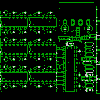14.9.2007 | 16:10
Ţráđlaust rafmagn komiđ lang á leiđ
The MIT researchers who developed the "WiTricity" wireless power technology haven't set their sights on global broadcast power just yet, but the team is already envisioning wirelessly transmitting power to laptops or cell phones across an office or inside a house. Because the power stream can be consistent, the devices would not even need batteries.
![]() Along with LPs, audio tape, and dial-up modems, children of the future might wonder what a "power cord" was. A team of researchers from MIT has demonstrated such a future, when they were recently able to light a 60-watt light bulb from an unconnected source about seven feet away.
Along with LPs, audio tape, and dial-up modems, children of the future might wonder what a "power cord" was. A team of researchers from MIT has demonstrated such a future, when they were recently able to light a 60-watt light bulb from an unconnected source about seven feet away.
Team leader Professor Marin Soljacic describes the "eureka" moment as one he experienced in his pajamas a few years ago. He was looking at his cell phone on the kitchen counter. "It was probably the sixth time that month that I was awakened by my cell phone beeping to let me know that I had forgotten to charge it," he said in a statement. "It occurred to me that it would be so great if the thing took care of its own charging."
Two copper coils, each a self-resonant system, become the resonant couple. One is attached to a power source and acts as the transmitter. It emits a nonradiative magnetic field that is oscillating in the MHz range. The other coil resonates with this field, and receives the transmission. MIT physics undergraduate Robert Moffatt noted that this arrangement means that "most of the power not picked up by the receiving coil remains bound to the vicinity of the sending unit, instead of being radiated into the environment and lost."
http://www.sci-tech-today.com/story.xhtml?story_id=0320003QDCRK&page=1
6.9.2007 | 20:17
Scientists show off super fast Wi-Fi
Scientists in the United States are touting new technology that will allow Wi-Fi to transfer huge amounts of data over a very short distance.
The GEDC used a high frequency in the 60GHz band, and have achieved wireless data-transfer rates of 15Gbit/s over a span of one metre, according to the Associated Press. That translates into a download time of less than five seconds for a DVD-quality copy of a typical Hollywood movie.
The researchers believe these high frequencies are an untapped resource, as permission is not needed from the US government to use this spectrum, which (like the 2.4GHz and 5GHz bands used by Wi-Fi) is unlicensed. This has previously led to talk of a goldrush in 60GHz spectrum.
Unlike higher frequencies, UWB currently has a maximum speed of about 480Mbit/s, which while sounding impressive, may not be enough for all applications.
Laskar has set his sights on a $5 chip, and so far his researchers have apparently hammered together a few prototypes to show off the technology.
Um bloggiđ
Arnór Jónsson
Bloggvinir
Heimsóknir
Flettingar
- Í dag (1.4.): 1
- Sl. sólarhring: 1
- Sl. viku: 8
- Frá upphafi: 267
Annađ
- Innlit í dag: 1
- Innlit sl. viku: 7
- Gestir í dag: 1
- IP-tölur í dag: 1
Uppfćrt á 3 mín. fresti.
Skýringar

